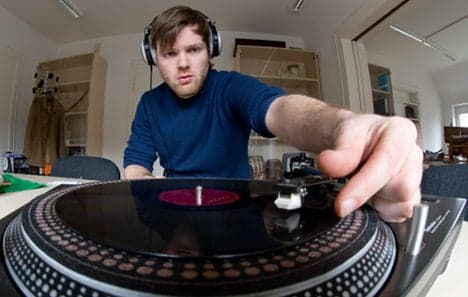Dusty discs unite Germany and Iran

Germany and Iran have found an unexpected common ground in music, after a Tehran museum approached German experts for help with restoring and digitising thousands of gramophone records from the early 20th century.
After a group of early music technology buffs in the east German city of Hildesheim restored a collection of old Egyptian recordings, some Iranian PhD students at the town's university recalled that there was an archive of dusty shellac-based records sat in a university museum in capital city Tehran.
The 30,000 outdated gramophone records made from shellac - the precursor to vinyl - date from between 1906 and 1932 and had been tucked away for years.
When museum staff in Iran got wind of the group in Hildesheim, a delegation came over and a bond was forged – Hildesheim and Tehran would work together in the name of preserving music history.
German experts and students now regularly travel to Tehran to work on cleaning and digitising the entire collection - mostly recordings of small ensembles of music scholars playing oriental music.
With a budget of just €60,000 from the regional Lower Saxon Foundation and the German foreign ministry, the restoration work will likely continue until the end of 2013. An unearthed electricity supply at the Tehran means that the process will be a particularly lengthy one, as the power cuts out regularly.
Almost all of the records originate from Hannover, as “at that time Iran's rulers were fascinated with technology and found everything that came from the west to be exciting,” said Raimund Vogels, director of the Hildesheim Centre for World Music, on Wednesday.
The shellac records first arrived in Tehran shortly after the turn of the 20th century, when Turkish traders turned up in the city in a caravan carrying disks. By 1906, recordings of Iranian music had been created in Hannover and shipped to Iran, just a few years after mass production of recorded music began.
“What's cool about these disks is that they show the top talent of the time,” said Vogels. His Iranian counterpart from the museum, Farzin Pirouzpey, added that digitising them would give Iranian music a more accessible place on the world stage.
Pirouzpey also said that he was thrilled that visitors to the museum would soon be able to listen to music that had not been heard in years.
The project has spawned more than just a revived music collection, Tehran and Hildesheim university are now planning on introducing a joint masters programme which would involve regular exchanges between the two countries.
DPA/The Local/jcw
Comments
See Also
After a group of early music technology buffs in the east German city of Hildesheim restored a collection of old Egyptian recordings, some Iranian PhD students at the town's university recalled that there was an archive of dusty shellac-based records sat in a university museum in capital city Tehran.
The 30,000 outdated gramophone records made from shellac - the precursor to vinyl - date from between 1906 and 1932 and had been tucked away for years.
When museum staff in Iran got wind of the group in Hildesheim, a delegation came over and a bond was forged – Hildesheim and Tehran would work together in the name of preserving music history.
German experts and students now regularly travel to Tehran to work on cleaning and digitising the entire collection - mostly recordings of small ensembles of music scholars playing oriental music.
With a budget of just €60,000 from the regional Lower Saxon Foundation and the German foreign ministry, the restoration work will likely continue until the end of 2013. An unearthed electricity supply at the Tehran means that the process will be a particularly lengthy one, as the power cuts out regularly.
Almost all of the records originate from Hannover, as “at that time Iran's rulers were fascinated with technology and found everything that came from the west to be exciting,” said Raimund Vogels, director of the Hildesheim Centre for World Music, on Wednesday.
The shellac records first arrived in Tehran shortly after the turn of the 20th century, when Turkish traders turned up in the city in a caravan carrying disks. By 1906, recordings of Iranian music had been created in Hannover and shipped to Iran, just a few years after mass production of recorded music began.
“What's cool about these disks is that they show the top talent of the time,” said Vogels. His Iranian counterpart from the museum, Farzin Pirouzpey, added that digitising them would give Iranian music a more accessible place on the world stage.
Pirouzpey also said that he was thrilled that visitors to the museum would soon be able to listen to music that had not been heard in years.
The project has spawned more than just a revived music collection, Tehran and Hildesheim university are now planning on introducing a joint masters programme which would involve regular exchanges between the two countries.
DPA/The Local/jcw
Join the conversation in our comments section below. Share your own views and experience and if you have a question or suggestion for our journalists then email us at [email protected].
Please keep comments civil, constructive and on topic – and make sure to read our terms of use before getting involved.
Please log in here to leave a comment.